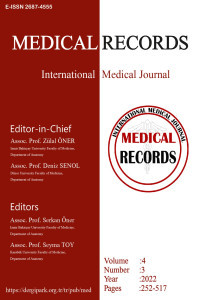BOTULİNUM TOKSİNİ ENJEKSİYONU UYGULANAN SEREBRAL PALSİLİ ÇOCUKLARDA GASTROKNEMİUS SPASTİSİTESİNİN SHEAR-WAVE ELASTOGRAFİ YÖNTEMİ İLE DEĞERLENDİRİLMESİ: ÖLÇÜM İÇİN UYGUN POZİSYONU BELİRLEME
elastografi, sonoelastografi, serebral palsi
Evaluation of Gastrocnemius Spasticity With Shear-Wave Elastography in Children with Cerebral Palsy after Botulinum Toxin Injection: Defining A Proper Position for Measurement
elastography, sonoelastography, cerebral palsy,
___
- 1. Bax M, Goldstein M, Rosenbaum P, et al. Proposed definition and classification of cerebral palsy. Dev Med Child Neurol. 2005;47:571–6.
- 2. Cans C. Surveillance of Cerebral Palsy in Europe: a collaboration of cerebral palsy surveys and registers. Dev Med Child Neurol. 2000;42:816–24.
- 3. Liu JM, Li S, Lin Q, Li Z. Prevalence of cerebral palsy in China. Int J Epidemiol. 1999;28:949-54.
- 4. Haerer AF, Anderson DW, Schoenberg BS. Prevalence of cerebral palsy in the biracial population of Copiah County, Mississippi. Dev Med Child Neurol. 1984;26:195-9.
- 5. Reddihough DS, Collins KJ. The epidemiology and causes of cerebral palsy. Aust J Physiother. 2003;49:7-12.
- 6. Clopton N, Dutton J, Featherston T, et al. Interrater and intrarater reliability of the Modified Ashworth Scale in children with hypertonia. Pediatr Phys Ther. 2005;17:268-73.
- 7. Brandenburg JE, Eby SF, Song P, et al. Ultrasound elastography: the new frontier in direct measurement of muscle stiffness. Arch Phys Med Rehabil. 2014;95:2207-19.
- 8. Pedersen M, Fredberg U, Langberg H. Sonoelastography as a diagnostic tool in the assessment of musculoskeletal alterations: a systematic review. Ultraschall Med. 2012;33:441-6.
- 9. Vasilescu D, Vasilescu D, Dudea S, et al. Sonoelastography contribution in cerebral palsy spasticity treatment assessment, preliminary report: a systematic review of the literature apropos of seven patients. Med Ultrason. 2010;12:306-10.
- 10. Maisetti O, Hug F, Bouillard K, Nordez A. Characterization of passive elastic properties of the human medial gastrocnemius muscle belly using supersonic shear imaging. J Biomech. 2012;45:978-84.
- 11. Kwon DR, Park GY, Lee SU, Chung I. Spastic cerebral palsy in children: dynamic sonoelastographic findings of medial gastrocnemius. Radiology. 2012;263:794-801.
- 12. Koman LA, Mooney JF, Smith B, et al. Management of cerebral palsy with Botulinum-A toxin: preliminary investigation. J. Pediatr Orthop. 1993;13:489–95.
- 13. Aoki KR. Pharmacology and immunology of botulinum toxin type A. Clin Dermatol. 2003;21:476–80.
- 14. Kahraman A, Seyhan K, Deger U, et al. Should botulinum toxin A injections be repeated in children with cerebral palsy? A systematic review. Dev Med Child Neurol. 2016;58:910-7.
- 15. Flett PJ. Rehabilitation of spasticity and related problems in childhood cerebral palsy. J Paediatr Child Health. 2003;39:6-14.
- 16. Pavone V, Testa G, Restivo DA, et al. Botulinum toxin treatment for limb spasticity in childhood cerebral palsy. Front Pharmacol. 2016;7:29.
- 17. Wu CH, Wang TG. Measurement of muscle stiffness in children with spastic cerebral palsy. Radiology. 2012;265:647; author reply 647-8.
- 18. Chino K, Akagi R, Dohi M, et al. Reliability and validity of quantifying absolute muscle hardness using ultrasound elastography. PLoS One. 2012;7:e45764.
- 19. Akagi R, Chino K, Dohi M, Takahashi H. Relationships between muscle size and hardness of the medial gastrocnemius at different ankle joint angles in young men. Acta Radiol. 2012;53:307-11.
- 20. Park GY, Kwon DR. Sonoelastographic evaluation of medial gastrocnemius muscles intrinsic stiffness after rehabilitation therapy with botulinum toxin a injection in spastic cerebral palsy. Arch Phys Med Rehabil. 2012;93:2085-9.
- 21. Arda K, Ciledag N, Aktas E, et al. Quantitative assessment of normal soft-tissue elasticity using shear-wave ultrasound elastography. AJR Am J Roentgenol. 2011;197:532-6.
- 22. Chin TY, Nattrass GR, Selber P, Graham HK. Accuracy of intramuscular injection of botulinum toxin A in juvenile cerebral palsy; a comparison between manual needle placement and placement guided by electrical stimulation. J Pediatr Orthop. 2005;25:286–9.
- Yayın Aralığı: Yılda 3 Sayı
- Başlangıç: 2019
- Yayıncı: Zülal ÖNER
Sacrum Kemiğinin Morfometrisi ve Varyasyonu
Gökçe BAĞCI UZUN, Merve AYDIN, Burcu KAMAŞAK, Büşra ZENCİRCİ, Tufan ULCAY, Mehtap NİSARİ, Hıdır PEKMEZ
Surgical Fixation with Cannulated Screws in the Adult Femoral Neck Fractures
İsmail GÜZEL, Oktay BELHAN, Tarık ALTUNKILIÇ
İrem AKOVA, Mehmet Emin ÖZDEMİR
Peptik Ülser Hastalarında Helicobacter pylori ile Barsak Parazitleri Arasındaki İlişki
Yasemin KAYA, Ülkü KARAMAN, Cemil ÇOLAK, Hamza ÇINAR, Ahmet KARATAŞ, Neval Berrin ARSERİM, Gamze YOLALAN, Şermin TOP
Orbitofrontal Cortex Volumes in Patients Diagnosed with Somatic Symptom Disorder
Burcu SIRLIER EMİR, Murad ATMACA, Aslı KAZĞAN KILIÇASLAN, Sevler YILDIZ, Hanefi YILDIRIM
Orhan GÜVENÇ, Mesut ENGİN, Senol YAVUZ
Cerrahi menapozun kadınlarda vasomotor semptomlar ve anksiyete üzerine etkisi: Prospektif çalışma
Ceren GÖLBAŞI, Hakan GÖLBAŞI, Burak BAYRAKTAR, Elif UÇAR, İbrahim ÖMEROĞLU, Şeyda KAYHAN OMEROGLU, Cüneyt Eftal TANER
Oxidative Stress and Inflammation Markers in Undescended Testes Patients
Semih Lütfi MİRAPOĞLU, Aytekin KAYMAKCI, Sümeyye AKIN, Fatih GÜLTEKİN, Eray Metin GÜLER
Vitamin D, VDR, and VDBP Levels Correlate with Anti-inflammatory Cytokine Profile in FMS Patients
